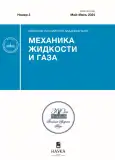Peculiarities of the Interstellar Dust Distribution in the Heliosphere Induced by the Time-Dependent Magnetic Field
- Autores: Godenko E.A.1,2,3, Izmodenov V.V.1,2,3
-
Afiliações:
- Space Research Institute of RAS
- Ishlinsky Institute for Problems in Mechanics of RAS
- Lomonosov Moscow State University
- Edição: Nº 3 (2024)
- Páginas: 154-166
- Seção: Articles
- URL: https://journal-vniispk.ru/1024-7084/article/view/280041
- DOI: https://doi.org/10.31857/S1024708424030112
- EDN: https://elibrary.ru/PFDJEI
- ID: 280041
Citar
Texto integral
Resumo
Interstellar dust enters the heliosphere due to the relative motion of the Sun and the Local Interstellar Cloud, which contains the Sun. The dynamics of interstellar dust particles is governed mainly by the electromagnetic force. The direction of this force depends on the polarity of the heliospheric magnetic field. In turn, polarity is a function of position and time and depends on the orientation of the solar magnetic dipole axis relative to the solar rotation axis. Previously it was shown that for the case when the magnetic dipole axis coincides with the solar rotation axis, the electromagnetic force acting on dust particles is directed towards the solar equatorial plane in both the northern and southern solar hemispheres. As a result, under the influence of such a force, the distribution of interstellar dust becomes highly inhomogeneous and, in particular, thin regions of increased number density (caustics) are formed. The goal of this work is to study the nature of caustics for a more realistic time-dependent model, when it is assumed that the magnetic dipole axis rotates relative to the solar rotation axis with a period of 22 years in accordance with the 22-year solar cycle. In addition, the magnetic dipole axis rotates due to the rotation of the Sun with a period of 25 days. To calculate the dust number density, the Lagrangian Osiptsov method is used. The shape and evolution of the resulting caustics are examined and the physical mechanisms of their origin are discussed. It is shown that, when taking into account time-dependent effects, caustics appear only in certain phases of the 22-year solar cycle, and then disappear.
Palavras-chave
Sobre autores
E. Godenko
Space Research Institute of RAS; Ishlinsky Institute for Problems in Mechanics of RAS; Lomonosov Moscow State University
Autor responsável pela correspondência
Email: godenko.egor@yandex.ru
Rússia, Moscow, 117485; Moscow, 119526; Moscow, 119991
V. Izmodenov
Space Research Institute of RAS; Ishlinsky Institute for Problems in Mechanics of RAS; Lomonosov Moscow State University
Email: godenko.egor@yandex.ru
Rússia, Moscow, 117485; Moscow, 119526; Moscow, 119991
Bibliografia
- Baranov V.B., Izmodenov V.V. // Fluid Dynamics. 2006. V. 41. P. 689.
- Griin E., Zook H.A., Baguhl M., Balogh A., Bame S.J., Fechtig H., Forsyth R., Hanner M.S., Horanyi M., Kissel J., Lindblad B.-A., Linkert D., Linkert G., Mann I., McDonnell J. A. M., Morfill G.E., Phillips J.L., Polanskey C., Schwehm G., Siddique N., Staubach P., Svestka J., Taylor A. // Nature. 1993. V. 362. P. 428.
- Wang S., Li A., Jiang B.W. // The Astrophysical Journal. 2015. V. 811. P. 38.
- Altobelli N., Postberg F., Fiege K., Trieloff M., Kimura H., Sterken V.J., Hsu H.W., Hillier J., Khawaja N., Moragas-Klostermeyer G., Blum J., Burton M., Srama R., Kempf S., Grün E. // Science. 2016. V. 352. P. 312.
- Godenko E.A., Izmodenov V.V. // Advances in Space Research. 2023. V. 72. P. 5142.
- Smith E.J. // Journal of Geophysical Research. 2001. V. 106. P. 15819.
- Jokipii J.R., Thomas B. // The Astrophysical Journal. 1981. V. 243. P. 1115.
- Hoeksema J.T. // Space Science Reviews. 1995. V. 72. P. 137.
- Mishchenko A.V., Godenko E.A., Izmodenov V.V. // MNRAS. 2020. V. 491. P. 2808.
- Godenko E.A., Izmodenov V.V. // Astronomy Letters. 2021. V. 47. P. 50.
- Godenko E.A., Izmodenov V.V. // Fluid Dynamics. 2023. V. 58. P. 274.
- Osiptsov A.N. // Astrophysics and Space Science. 2000. V. 274. P. 377.
- Osiptsov A.N. // Fluid Dynamics. 2024. V. 59. P. 1.
- Landgraf M. // Journal of Geophysical Research. 2000. V. 105. P. 10303.
- Sterken V.J., Altobelli N., Kempf S., Schwehm G., Srama R., Grün E. // Astronomy and Astrophysics. 2012. V. 538. P. A102.
- Slavin J.D., Frisch P.C., Muller H.-R., Heerikhuisen J., Pogorelov N.V., Reach W.T., Zank G. // The Astrophysical Journal. 2012. V. 760. P. 46.
- Alexashov D.B., Katushkina O.A., Izmodenov V.V., Akaev P.S. // MNRAS. 2016. V. 458. P. 2553.
- Strub P., Sterken V.J., Soja R., Krüger H., Grün E., Srama R. // Astronomy and Astrophysics. 2019. V. 621. P. A54.
- Kempf S., Srama R., Altobelli N., Auer S., Tschernjawski V., Bradley J., Burton M.E., Helfert S., Johnson T.V., Krüger H., Moragas-Klostermeyer G., Grün E. // Icarus. 2004. V. 171. P. 317.
- Weingartner J.C., Draine B.T. // The Astrophysical Journal Supplement Series. 2001. V. 134. P. 263.
- Parker E.N. // The Astrophysical Journal. 1958. V. 128. P. 664.
- Kimura H., Mann I. // Meteroids 1998 edited by Baggaley W.J. and Porubcan V. 1999. P. 283.
Arquivos suplementares









